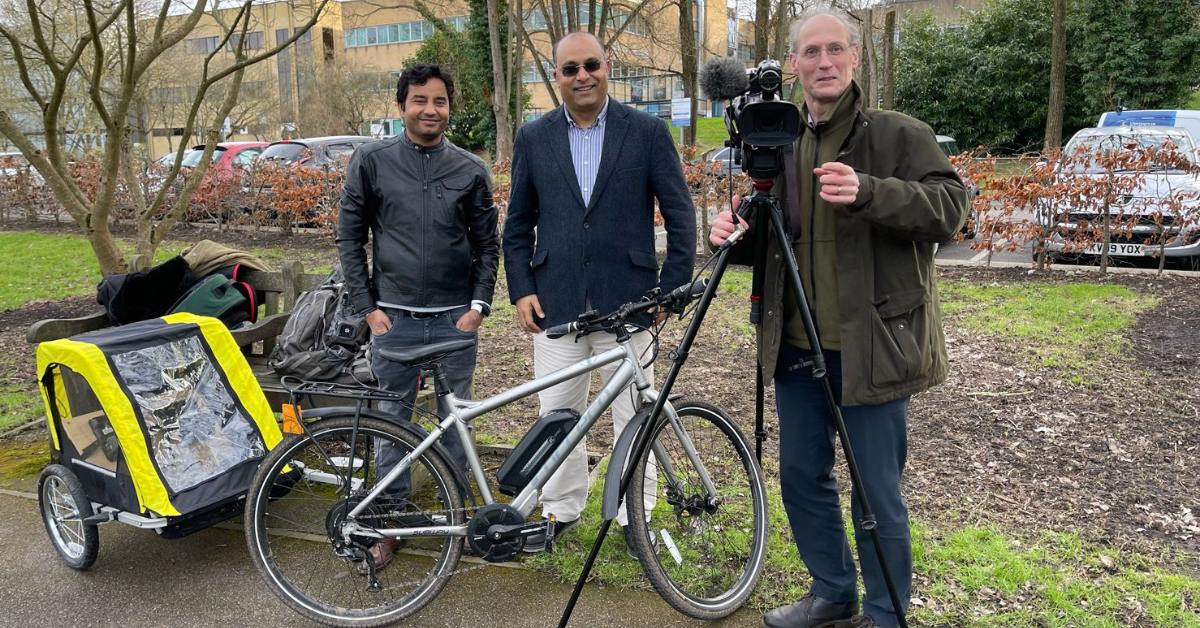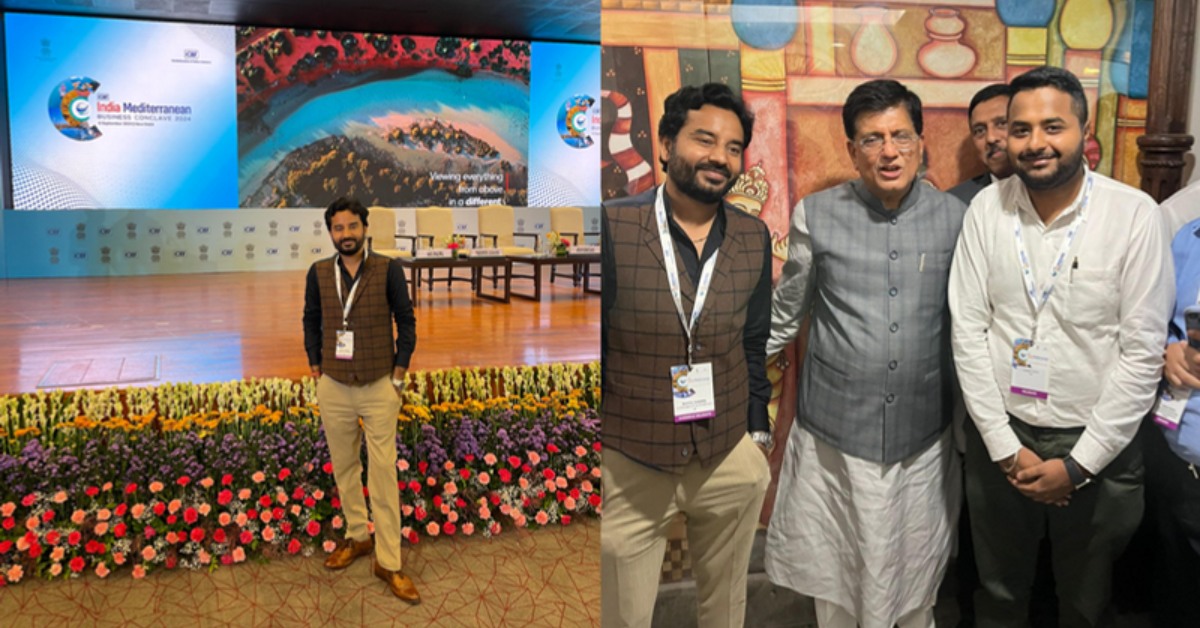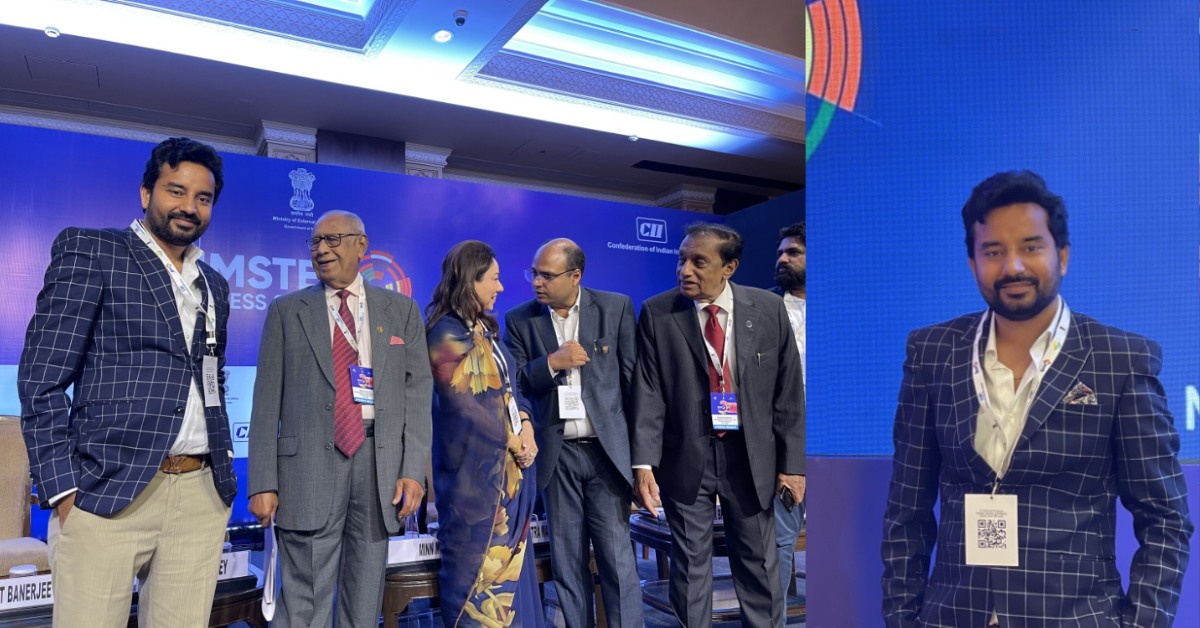It Starts With a Breath: What I Learnt About India’s Cities From Babies, Blocked Streets & Hopeful Citizens
From Research to Action: Bridging Air Quality, Citizen Engagement, and Urban Sustainability
— A Journey Shaped by Global Experiences and Local Impact
Dr. Ashish Sharma holds a PhD in Civil and Environmental Engineering from the University of Surrey (UK), where his research on reducing air pollution exposure in young children gained global recognition and was featured in BBC, Forbes, and The Telegraph. He has conducted research at leading institutions including University of Surrey (UK), GIST (South Korea), Macquarie University (Australia), and the University of Toledo (USA).
Dr Sharma has presented at major international forums such as the Cambridge Particle Meeting, IAQM (UK), World Environment Expo 2022, Smart Cities Conference New Delhi 2017 and several other conferences across Australia, Brazil, Egypt, UK and the U.S. His expertise spans air quality, exposure science, urban sustainability, and public health. He is passionate about bridging science, policy, and community action to build cleaner, healthier cities.
This is the first in a two-part series exploring how India can build cleaner, more just, and breathable cities by putting people, not policies, at the heart of climate action.
What if the fight for clean air isn’t just about emissions and enforcement, but about strollers, footpaths, and the quiet resilience of everyday people?
Dr. Ashish Sharma’s journey from global research labs to India’s smog-choked streets reveals a truth we often overlook: real change begins when science meets empathy. In a world where babies breathe in more pollutants than their parents and the urban poor suffer silently while policies stall, Sharma shows us how citizen science, behavioural shifts, and grassroots innovation can pave the way for cities that not only survive but breathe.
From global labs to local streets
How do we make our cities cleaner, our air safer, and our communities stronger? After spending over a decade working in laboratories, classrooms, field projects, and ministries, I’ve come to believe that the answers lie not only in data or policy but also in people.
My journey from academic labs in the UK (University of Surrey, Guildford), Australia (Macquarie University, Sydney), South Korea (Gwangju Institute of Science and Technology), and the US (University of Toledo, Ohio) to the bustling lanes of Delhi (TRIPP IIT Delhi) and Aligarh (Aligarh Muslim University Aligarh, UP) has taught me that urban sustainability is not just a scientific puzzle but a deeply human challenge.
In this piece, I want to share the lessons I’ve gathered through research, risk, and real-world engagement about how cleaner air and more livable cities are not distant dreams but within reach.
The hidden emergency in our breath
Air pollution doesn’t knock on your door. It seeps in quietly—through windows, lungs, and childhoods. In India, it contributes to nearly one in every ten deaths. During my PhD at the University of Surrey, I focused on one of the most vulnerable groups—babies in prams.
Our findings were startling: children in prams are exposed to up to 60% more pollutants than adults. Their breathing height puts them right in line with vehicle exhaust. Some children face up to 72% higher pollution levels simply based on where they sit in a double pram.
But knowledge alone isn’t power. Action is. So we created practical, scalable interventions—pram covers, urban route mapping, low-cost sensors—and tested them in real-world conditions. The Mitigating Air Pollution Exposure (MAPE) project, funded by UKRI, was not just a research study. It became a guide for urban parents navigating toxic streets.
These insights shaped public conversations, informed policies, and, perhaps most importantly, gave families the tools to protect their children now, not just in the distant future.
 During his PhD, Dr Ashish found that babies in prams inhale up to 60% more pollution than adults.
During his PhD, Dr Ashish found that babies in prams inhale up to 60% more pollution than adults.
Dr. Ashish Sharma, together with his PhD supervisor Prof. Prashant Kumar, was featured during a BBC visit to the University of Surrey campus, highlighting their innovative experimental setup for air pollution monitoring using electric bike trailers. Prof. Prashant Kumar is the Co-Director of the Institute for Sustainability, Professor and Chair in Air Quality and Health, and Founding Director of the Global Centre for Clean Air Research (GCARE) at the University of Surrey, Guildford, UK.
At Surrey, we’ve also studied the efficacy of face masks during pollution peaks. Our GCARE team found that while FFP3 respirators filtered nearly 97% of harmful particles, medical and cloth masks offered moderate protection. This work, especially during the pandemic, helped inform personal protection strategies for millions.
But real impact happens when citizens become scientists.
When science stays on paper, people pay the price
Despite the mountains of data and well-meaning policies, the gap between research and action remains wide. That’s why I founded Sustainability Alternatives UK — to turn insights into solutions.
Championing the twin transition for SMEs
On Tuesday, 21 February 2023, I had the privilege of speaking at a webinar hosted by the Institution of Environmental Sciences (IES), titled “SMEs Twin Transition: Towards Sustainability and Digital Transformation.” As the Founding CEO of Sustainability Alternatives Ltd. (UK) and a Principal Research Scientist at IIT Delhi, I took this opportunity to spotlight the critical role of small and medium enterprises (SMEs) in shaping resilient, future-ready economies.
In my talk, I emphasised an increasingly urgent truth: the convergence of sustainability and digital innovation is no longer optional — it is existential. Especially in the context of post-pandemic recovery, SMEs cannot afford to view sustainability and digital transformation as luxuries. These are the pillars that will determine their survival and success.
I also wanted to challenge a prevailing misconception — that sustainability is a domain exclusive to large multinational corporations. I firmly believe that if we are serious about inclusive progress, we must democratise both sustainability and digital inclusion. SMEs are the backbone of most economies. Leaving them behind means leaving behind the communities, jobs, and innovations that they drive.
 Empowering SMEs with green tech and digital tools is key to building sustainable, future-ready economies. (Representational picture source: Shutterstock)
Empowering SMEs with green tech and digital tools is key to building sustainable, future-ready economies. (Representational picture source: Shutterstock)
That’s why I advocated for giving SMEs real access to cutting-edge technologies, ESG tools, and innovative business models. These resources are essential for environmental responsibility and carving out a competitive edge in today’s market.
Throughout the session, I shared practical insights and explored promising tech solutions that can enable SME leaders — whether they’re entrepreneurs or C-suite executives — to take actionable steps forward. Most importantly, I called for a mindset shift: we must all embrace a culture of learning, unlearning, and relearning if we want to keep pace with the fast-evolving landscape of Industry 4.0.
This is the moment to build bridges, not barriers, for SMEs stepping into a more sustainable and digitally empowered future. And I’m committed to helping make that happen.
Why collaboration matters now more than ever
While local action and community-led change are powerful, I’ve realised that big impact often needs big collaboration. Climate change, water stress, and digital divides don’t stop at borders—and the solutions shouldn’t either. That’s why regional cooperation is becoming such a critical piece of the sustainability puzzle.
India, in particular, is stepping up to play a bigger role—not just for itself, but as a connector between regions. Whether it’s Southeast Asia, Europe, or Africa, we’re building bridges that align with climate goals, innovation, and shared progress.
Connecting with the Mediterranean: A conversation that stayed with me
At the India-Mediterranean Business Conclave 2024 in New Delhi, I saw first-hand how this vision is taking shape. The room was filled with policymakers, business leaders, and changemakers—all discussing how India and the Mediterranean region can grow together in a way that’s not just profitable, but sustainable and future-ready.
One conversation that really stayed with me was a quick interaction with Hon. Shri Piyush Goyal, India’s Minister of Commerce and Industry. As we spoke, he said something that struck a chord: “India’s growth story is full of opportunities for the world.” That line perfectly captured the energy in the room. This wasn’t just about trade—it was about creating an economic corridor that connects continents through shared values: climate resilience, digital innovation, and inclusive development.
 Dr. Ashish Sharma with Hon. Shri Piyush Goyal, Union Minister of Commerce & Industry, at the India-Mediterranean Business Conclave 2024, discussing India’s role in building sustainable, strategic economic corridors.
Dr. Ashish Sharma with Hon. Shri Piyush Goyal, Union Minister of Commerce & Industry, at the India-Mediterranean Business Conclave 2024, discussing India’s role in building sustainable, strategic economic corridors.
The India-Mediterranean Business Corridor (IMBC) aims to transform connectivity through a number of strategic thrusts:
- High-capacity digital infrastructure, such as Reliance’s India-Europe subsea cable;
- Clean energy partnerships, especially in green hydrogen and blue economy sectors;
- Collaboration on Industry 4.0 technologies, with innovation hubs like Marseille and Indian tech cities;
- Port-led development and maritime logistics, including alignment with India’s Sagarmala initiative;
- Urban sustainability and smart manufacturing, backed by deeper people-to-people and research linkages.
By framing the IMBC as a bridge across Europe, Africa, and South Asia, India is catalysing a new model of corridor-led cooperation. A model that is not just economically viable but also climate-conscious and innovation-forward.
BIMSTEC: Strengthening Eastern Regionalism for Shared Resilience
At the Confederation of Indian Industry’s BIMSTEC Business Summit 2024, I had the opportunity to engage with high-level delegations from member countries, discussing the vital role of regional collaboration in addressing shared challenges. Climate change mitigation, adaptation, and environmental sustainability are now fundamental pillars within BIMSTEC’s evolving framework, reflecting the urgent need for cooperative solutions across borders.
The Bay of Bengal Initiative for Multi-Sectoral Technical and Economic Cooperation (BIMSTEC), comprising Bangladesh, Bhutan, India, Myanmar, Nepal, Sri Lanka, and Thailand – is emerging as a key platform for regional economic integration with sustainability at its core. At the 2024 BIMSTEC Business Summit, India’s eastern engagement took center stage as member nations underscored their collective commitment to climate resilience, clean technology collaboration, and inclusive development across one of the world’s most climate-vulnerable regions.
From green trade facilitation and eco-tourism infrastructure to nanotech for clean water and climate policy coordination, BIMSTEC is aligning economic integration with environmental stewardship. As one of the world’s most climate-vulnerable regions, this collaboration offers a powerful model for shared resilience, knowledge exchange, and inclusive, low-carbon growth.
In a region highly vulnerable to climate impacts such as rising sea levels, extreme weather events, and biodiversity loss, BIMSTEC offers a platform to synchronise policies, mobilise resources, and share knowledge, strengthening collective resilience and sustainable development goals.
By bridging national priorities with regional strategies, BIMSTEC is not just fostering economic cooperation but also pioneering pathways toward a climate-resilient and environmentally sustainable South and Southeast Asia.
 At the BIMSTEC Business Summit 2024 in New Delhi, Dr. Ashish Sharma engaged with delegates from Sri Lanka and other member nations, exploring opportunities for regional cooperation and development.
At the BIMSTEC Business Summit 2024 in New Delhi, Dr. Ashish Sharma engaged with delegates from Sri Lanka and other member nations, exploring opportunities for regional cooperation and development.
Together, the IMBC and BIMSTEC corridors symbolise India’s multi-vector approach to sustainable regional diplomacy. While IMBC anchors India’s strategic outreach to the west—connecting to Europe and Africa—BIMSTEC strengthens eastern ties across South and Southeast Asia.
In a world defined by both environmental urgency and evolving geopolitical dynamics, these twin initiatives offer more than economic opportunity. They embody a vision for a connected, resilient, and cooperative future—where connectivity is climate-smart, growth is inclusive, and diplomacy builds bridges, not walls.
India’s expanding role in both platforms illustrates how infrastructure, innovation, and sustainability can converge to drive regional transformation—and perhaps offer a model for other global partnerships in the making.
Conclusion
Clean air is not a privilege—it’s a right. And as Dr. Ashish Sharma’s journey shows, the solutions won’t come from policy documents alone, but from classrooms, footpaths, living rooms, and citizen-led labs. From babies in strollers to students conducting green audits, this is a people-powered movement—and it’s only just begun.
In Part 2, we dive deeper into what Indian cities must do now—from rethinking infrastructure and governance to embedding justice and empathy into every step of urban planning. Stay with us as we explore how citizens, not just cities, will shape the future of breathable India.
Disclaimer: The views and opinions expressed in this article are solely those of the author in a personal capacity. They do not necessarily reflect or represent the official positions, policies, or views of any organisation, employer, or affiliated institution.
Edited by Leila Badyari
News